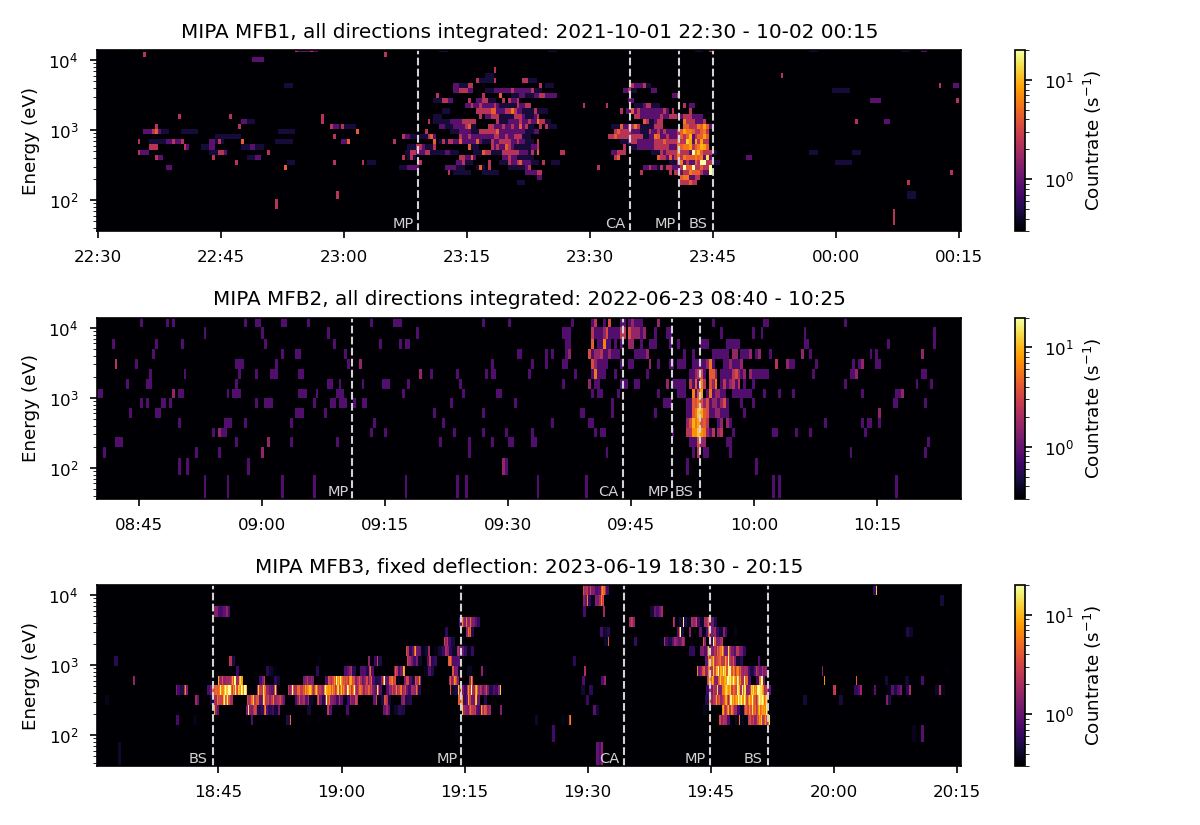Three flybys, three magnetospheres: MIPA observations from BepiColombo’s Mercury flybys
- 1Swedish Institute of Space Physics, Solar System Physics and Space Technology, Kiruna, Sweden (hayley@irf.se)
- 2INAF/Istituto di Astrofisica e Planetologia Spaziale
- 3Institut fuer Weltraumforschung
- 4Southwest Research Institute
The ESA/JAXA spacecraft BepiColombo has now made three gravity assist flybys of Mercury in 2021, 2022, and 2023. The Miniature Ion Precipitation Analyzer (MIPA) is a small ion spectrometer in the Search for Exospheric Refilling and Emitted Natural Abundance (SERENA) instrument suite on the Mercury Planetary Orbiter (MPO) and has taken plasma measurements during all flybys so far. MIPA consists of an electrostatic deflection system, which scans over both a hemispherical field of view and energies from ~40 eV to 14 keV, followed by a time-of-flight system, giving it limited mass resolution. The electrostatic deflection system is highly configurable, allowing MIPA to vary its angular, energy, and time resolution. MIPA is designed to measure solar wind precipitation at Mercury and as such is optimized for high fluxes of low mass ions [1].
The three Mercury flybys so far had similar trajectories, passing from the dusk tail flank through the dawn terminator to the dayside, with closest approach in the equatorial region on the nightside. There were slight variations in the inbound leg of the trajectory, with the first and second flybys entering the magnetosphere far down the tail region, while the third flyby was closer to the terminator. The instrument was operated in a different mode for each flyby, with higher energy and lower angular resolution for MFB1 than MFB2. For MFB3 in 2023, MIPA was run in “fixed deflection” mode, where the viewing direction was fixed to a single pixel and only energy was scanned over, resulting in data with a high time resolution of 375 ms per energy scan. The figure below shows a comparison of MIPA data from all three flybys, with the magnetosphere boundary crossings and closest approach marked. The data have been noise-subtracted using a novel Poisson statistical method.

Despite the similar trajectories, the MIPA data show clear differences between each flyby. In the first flyby, a lower latitude boundary layer was present before closest approach [2], which did not appear in the two subsequent flybys. However, MFB2 and MFB3 had clear detections of high energy ions near closest approach, indicative of a potential partial ring current such as was detected in MESSENGER data [3]. The different flybys show varying amounts of magnetospheric compression, indicative of changes in upstream solar wind conditions. This compression may be responsible for the appearance or disappearance of ion populations such as the low latitude boundary layer and possible ring current. We additionally discuss the changes in the MIPA outbound bow shock crossing data, which in MFB3 includes observations of the solar wind, normally outside MIPA’s field of view. These differences highlight the dynamic nature of Mercury’s magnetosphere and show the capabilities of MIPA for helping to understand it.
References:
[1] Orsini, S., et al. (2021). SERENA: Particle Instrument Suite for Determining the Sun-Mercury Interaction from BepiColombo. Space Science Reviews, 217(1), 11. https://doi.org/10.1007/s11214-020-00787-3
[2] Orsini, S., et al. (2022). Inner southern magnetosphere observation of Mercury via SERENA ion sensors in BepiColombo mission. Nature Communications, 13(1), Article 1. https://doi.org/10.1038/s41467-022-34988-x
[3] Zhao, J.-T., et al. (2022). Observational evidence of ring current in the magnetosphere of Mercury. Nature Communications, 13(1), 924. https://doi.org/10.1038/s41467-022-28521-3
How to cite: Williamson, H., Barabash, S., Wieser, M., Nilsson, H., Futaana, Y., Shimoyama, M., Orsini, S., Milillo, A., Aronica, A., Varsani, A., DeAngelis, E., and Livi, S.: Three flybys, three magnetospheres: MIPA observations from BepiColombo’s Mercury flybys, Europlanet Science Congress 2024, Berlin, Germany, 8–13 Sep 2024, EPSC2024-375, https://doi.org/10.5194/epsc2024-375, 2024.